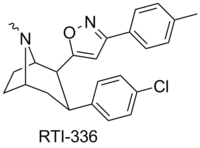RTI-336
RTI-336 | |
| 식별자 | |
|---|---|
| |
| CAS 번호 | |
| 펍켐 CID | |
| 켐스파이더 | |
| 유니 | |
| CompTox 대시보드 (EPA) | |
| 화학 및 물리적 데이터 | |
| 공식 | C24H25CLN2O |
| 어금질량 | 392.93 g·190−1 |
| 3D 모델(JSmol) | |
| |
| |
RTI(-4229)-336, (LS-193,309, (-------2β-(4-메틸페닐)이소사졸-5-yl)-3β-(4-클로로페닐)트로판)은 페닐트로판 유도체로, 강력한 선택적 도파민 재흡수 억제제 및 자극제 역할을 한다.코카인 친화력의 20배 정도인 도파민 운반체에 결합하지만,[1] 비교적 가벼운 자극제 효과를 내는데, 발작이 느리고 작용 기간이 길다.[2](단, 다른 출처는 페닐트로판들[3] 중에서 더 빠른 작용의 집합 중 하나를 가지는 것으로 분류한다.)이러한 특징들은 헤로인 남용 치료에 메타돈이 어떻게 사용되는지와 유사한 가능한 대체 약물로 코카인 중독 치료의 잠재적 후보자로 만든다.[4][5]RTI-336은 중독된 원숭이에서 코카인을 완전히 대체하고 자기 관리를 지원하며,[6][7] 특히 SSRI와 결합할 경우 코카인 사용률을 현저히 낮추고,[8] 인간 코카인 중독자들에게 실행 가능한 대체 약물이 될 수 있는지 여부를 결정하기 위한 연구가 진행 중이다.
갱신하다
인간 이외의 영장류에서 코카인에 비해 페닐트로판 코카인 아날로그 RTI-336 및 RTI-177의 보강강도가 낮다.
RTI-336에 의한 만성 도파민 전달 억제가 붉은털원숭이의 운동행동, 수면, 호르몬 수준에 미치는 영향.
코카인 남용에 대한 약리치료
코카인 남용에 대한 약리 요법으로 도파민 트랜스포터 선택적 RTI-336 개발(FIC, et al. 2006).
| RTI | X | R | [3H]CFT | [3H]니소세틴 | [3H]파록세틴 | N ÷ D | S ÷ D |
|---|---|---|---|---|---|---|---|
| 콕 | — | — | 89.1 | 3298 (1986) | 1045 (45) | 37.01 | 11.79 |
| 177 | CL | 페닐 | 1.28 | 504 (304) | 2420 (220) | 393.8 | 1891 |
| 176 | 나 | 페닐 | 1.58 | 398 (239) | 5110 (465) | 251.9 | 3234 |
| 354 | 나 | 에틸 | 1.62 | 299 (180) | 6400 (582) | 184.6 | 3951 |
| 336 | CL | 프톨릴 | 4.09 | 1714 (1033) | 5741 (522) | 419.1 | 1404 |
| 386 | 나 | p-아니실 | 3.93 | 756 (450) | 4027 (380) | 192.4 | 1025 |
참고 항목
참조
- ^ Carroll FI, Pawlush N, Kuhar MJ, Pollard GT, Howard JL (January 2004). "Synthesis, monoamine transporter binding properties, and behavioral pharmacology of a series of 3beta-(substituted phenyl)-2beta-(3'-substituted isoxazol-5-yl)tropanes". Journal of Medicinal Chemistry. 47 (2): 296–302. doi:10.1021/jm030453p. PMID 14711303.
- ^ Carroll FI, Fox BS, Kuhar MJ, Howard JL, Pollard GT, Schenk S (December 2006). "Effects of dopamine transporter selective 3-phenyltropane analogs on locomotor activity, drug discrimination, and cocaine self-administration after oral administration". European Journal of Pharmacology. 553 (1–3): 149–56. doi:10.1016/j.ejphar.2006.09.024. PMID 17067572.
- ^ Kimmel HL, O'Connor JA, Carroll FI, Howell LL (January 2007). "Faster onset and dopamine transporter selectivity predict stimulant and reinforcing effects of cocaine analogs in squirrel monkeys". Pharmacology, Biochemistry, and Behavior. 86 (1): 45–54. doi:10.1016/j.pbb.2006.12.006. PMC 1850383. PMID 17258302.
- ^ Carroll FI, Howard JL, Howell LL, Fox BS, Kuhar MJ (March 2006). "Development of the dopamine transporter selective RTI-336 as a pharmacotherapy for cocaine abuse". The AAPS Journal. 8 (1): E196-203. doi:10.1208/aapsj080124. PMC 2751440. PMID 16584128.
- ^ Sofuoglu M, Kosten TR (March 2006). "Emerging pharmacological strategies in the fight against cocaine addiction". Expert Opinion on Emerging Drugs. 11 (1): 91–8. doi:10.1517/14728214.11.1.91. PMID 16503828.
- ^ Kimmel HL, O'Connor JA, Carroll FI, Howell LL (January 2007). "Faster onset and dopamine transporter selectivity predict stimulant and reinforcing effects of cocaine analogs in squirrel monkeys". Pharmacology, Biochemistry, and Behavior. 86 (1): 45–54. doi:10.1016/j.pbb.2006.12.006. PMC 1850383. PMID 17258302.
- ^ Kimmel HL, Negus SS, Wilcox KM, Ewing SB, Stehouwer J, Goodman MM, et al. (September 2008). "Relationship between rate of drug uptake in brain and behavioral pharmacology of monoamine transporter inhibitors in rhesus monkeys". Pharmacology, Biochemistry, and Behavior. 90 (3): 453–62. doi:10.1016/j.pbb.2008.03.032. PMC 2453312. PMID 18468667.
- ^ Howell LL, Carroll FI, Votaw JR, Goodman MM, Kimmel HL (February 2007). "Effects of combined dopamine and serotonin transporter inhibitors on cocaine self-administration in rhesus monkeys". The Journal of Pharmacology and Experimental Therapeutics. 320 (2): 757–65. doi:10.1124/jpet.106.108324. PMID 17105829.
- ^ Navarro HA, Howard JL, Pollard GT, Carroll FI (April 2009). "Positive allosteric modulation of the human cannabinoid (CB) receptor by RTI-371, a selective inhibitor of the dopamine transporter". British Journal of Pharmacology. 156 (7): 1178–84. doi:10.1111/j.1476-5381.2009.00124.x. PMC 2697692. PMID 19226282.



